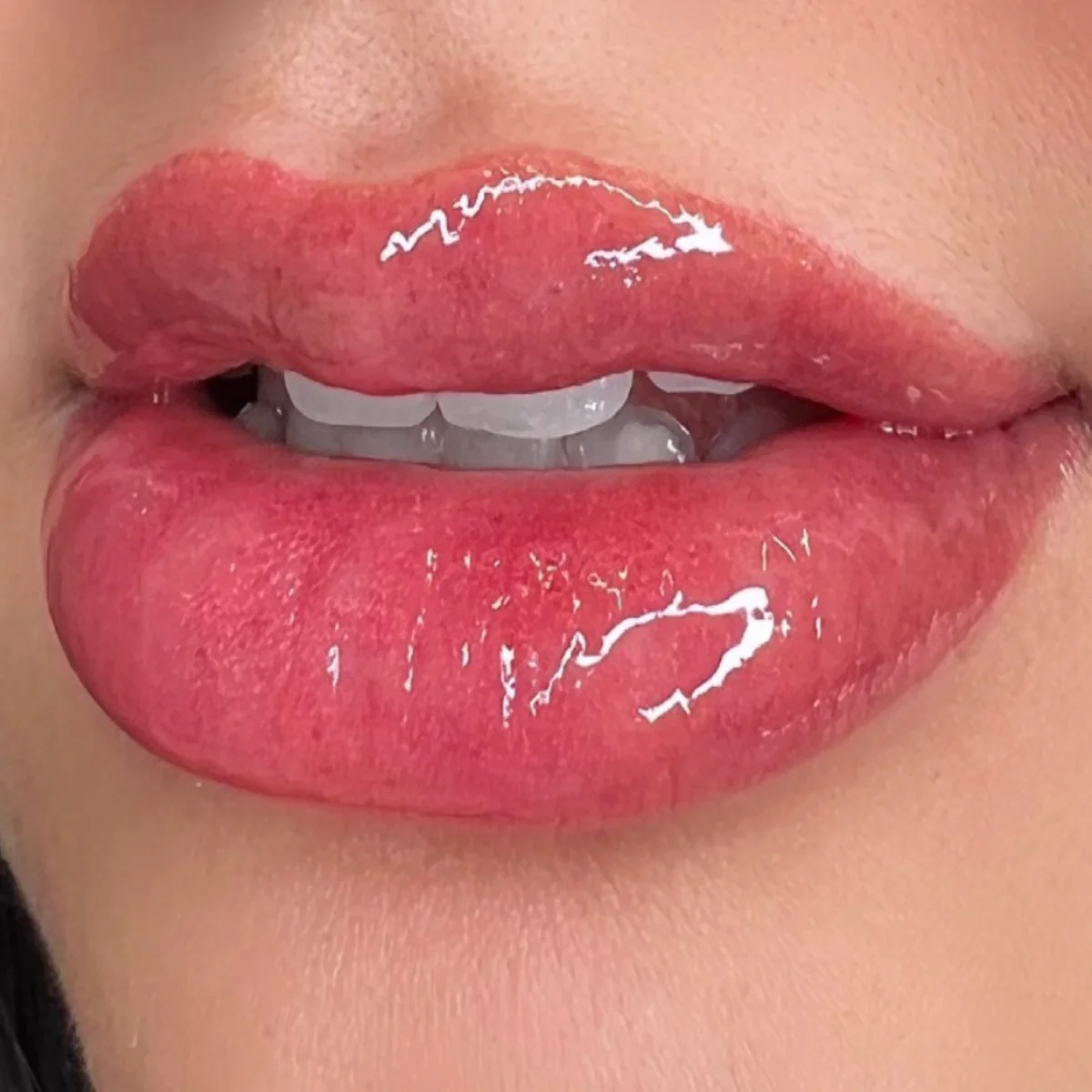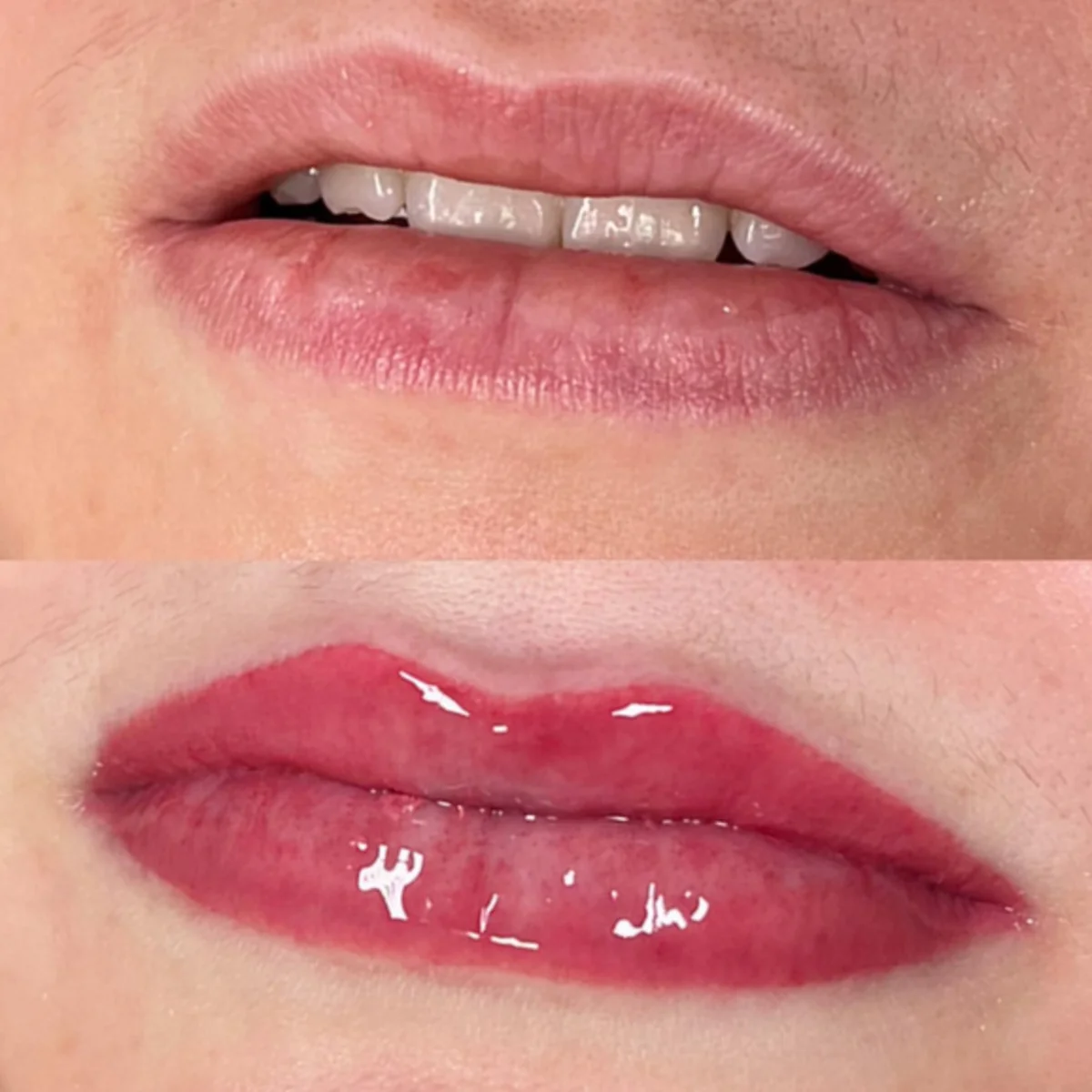Lip blushing is a cosmetic procedure that involves tattooing pigments into the lips to enhance their shape, colour, and overall appearance. It offers a semi-permanent solution for individuals seeking naturally beautiful and well-defined lips.

What is Lip Blush?
Lip blush tattoo is a semi-permanent lip tattooing that enhances the natural lip colour and shape, giving the illusion of fuller lips. It provides natural results once healed, unlike filler, which creates volume but may not look as natural.
Traditional permanent makeup uses a robust machine and synthetic pigments deep in the dermis. Today's permanent makeup results are more natural, with lips having a stained appearance rather than a solid block of colour. The intensity can be adjusted based on each client's desired outcome.
Appointment
- The process begins with pout prep, where a topical anaesthetic is applied to numb the lips for 20 minutes. Your technician will then outline the shape of the lips for review and any necessary adjustments.
- After removing the numbing cream, the shaping process begins by making the cupid's bow more pronounced and adding fullness to the sides of the lips where the natural colour might be lost. Once the client is satisfied with the shape, the tattooing procedure commences.
- The procedure typically lasts one to one and a half hours, potentially longer depending on desired results. After the appointment, expect some swelling due to the tattooing process, which can be managed with ice. Healing may include scabbing over the next week, so plan accordingly.
- Aftercare cream should be applied to the lips for 3-5 days.
- During the first 24 hours, it is recommended for clients to gently blot their lips with a wet cotton pad and allow them to air dry to keep the lips clean and prevent the formation of scabs from body fluids.
Scabs must fall off naturally to avoid potential scarring or loss of pigment in the affected areas.
Factors to consider before treatment
- Aspirin
- Ibuprofen
- Fish oil
- Vitamin E
Post-treatment care
Refraining from eating out and sun exposure for two weeks after the procedure is recommended. If getting injections, it is advised to wait a whole month. Avoid sleeping on your face to prevent scabs from falling off prematurely. Avoid spicy food, citrus, and hot drinks for three days. Use an occlusive ointment such as Stratamed or Bepanthen to moisturise the lips.
The colour may appear very vibrant at first, similar to a lip stain. However, this immediate result is not indicative of the final look. After healing, the colour will fade by around 30-50% and blend with the natural lip colour.
Potential risks
Lip blushing may not be suitable for everyone, so it is essential to review the contraindications carefully. If any of the following conditions apply to you, it is recommended that you avoid this procedure.
- Smoking may affect pigment retention and colour distortion.
- Psoriasis has been diagnosed in the treatment area.
- You have been diagnosed with an autoimmune disease.
- Medical conditions such as thyroid/Graves' disease and anemia may affect the retention of pigment.
- You have a history of keloid or hypertrophic scarring.
- You are currently receiving chemotherapy treatment.
- This service is not available to individuals who are pregnant or nursing.
- Individuals may have either type 1 or type 2 diabetes, which can result in slow healing and an increased risk of infection, potentially impacting the retention of colour.
- Patients under a doctor's care should seek written approval before undergoing any procedure.
- Individuals who tend to develop cold sores.
Prepare for your Lip Blushing session
- It is recommended to avoid taking aspirin, ibuprofen, fish oils, vitamin E, or niacin or consuming excessive alcohol at least 48 hours before and after your procedure.
- Refraining from taking prescription blood thinners for at least 48 hours before and after your procedure is recommended.
- Before your cosmetic tattoo procedure, it is advised to stop using vitamin A skin care products like Retin-A or retinol at least two weeks prior. It is also recommended to avoid using these products around the tattooed area afterwards, as they could potentially cause fading and colour distortion.
- Before getting a tattoo, it is recommended to stop using AHA skin care products in the area for at least one week before the procedure.
- Avoid performing laser or electrolysis treatments on or around the treatment area one week before the procedure.
- It is advised to refrain from using Botox or fillers in the procedure area within one week.
- It is recommended to schedule trips or events at least 14 days after the procedure. Additionally, reducing caffeine intake on the morning of your appointment is advised to avoid any potential complications.
- It is recommended to avoid chemical peels, dermabrasions, mesotherapy, or other intensive treatments that may accelerate skin cell rejuvenation and cause skin irritation for 3-4 weeks before the procedure.
- Individuals who have taken prescription Accutane in the past should wait a minimum of one year before contemplating this procedure.
- Refraining from sun and tanning bed exposure for 30 days before and after your procedure is advised. If you arrive with a new tan or sunburn, you must reschedule and forfeit your booking fee. The pigment may fade as your skin exfoliates from a sunburn.
- Please bring your favourite lip colour if you have a specific shade in mind. Remember that we cannot make a colour lighter than your natural skin tone.
- Please get in touch with us before booking your appointment if you have existing cosmetic tattooing.

How Permanent Is It?
Permanent makeup results can vary among individuals, typically lasting 2-5 years with an initial session and touch-up. Additional touch-ups may be needed for the desired look. It's important to note that permanent makeup ink does not last as long as body art ink due to design differences.
The longevity of lip blushing varies depending on individual factors such as lifestyle habits and skin conditions. Factors like smoking, sun exposure, oil-prone skin, iron deficiency, and using exfoliating products can all impact the fading process of the pigment.